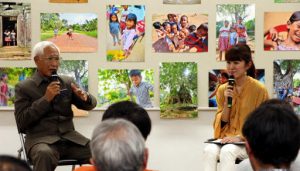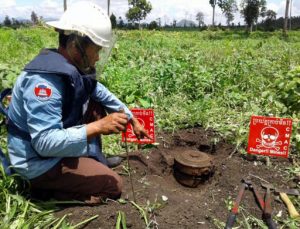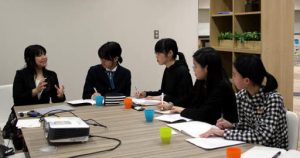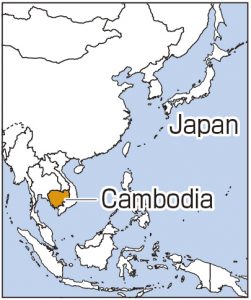Junior writers consider Cambodia: Ways to lend support to the Cambodian people
Apr. 16, 2019
The people of Cambodia suffered greatly during the civil wars which plagued that nation from the 1970s to the 1990s. These conflicts were complex and long-lasting, and included the ouster of Norodom Sihanouk as head of state; the mass killing perpetrated by the Pol Pot regime, which took the lives of two million Cambodians; and the military intervention made by neighboring Vietnamese forces. During this period, countless land mines were buried beneath the Cambodian soil, a terrible problem which hinders that nation’s reconstruction and development while also contributing to the poverty of children and the economic disparity in Cambodia.
For this article, the junior writers of the Chugoku Shimbun met with people in Japan who are showing solidarity with the people of Cambodia and engaging in activities that can provide support. At the same time, we also considered what we could do to help Cambodians from Hiroshima.
Japanese volunteer removes buried land mines with local residents
A land mine is a type of weapon that is buried underground and then detonates when a person or vehicle passes over it, causing great damage. During the time of civil war in Cambodia, a huge number of land mines were buried near private homes and fields.
It is estimated that about four to six million land mines are still hidden beneath the ground. Because of this, people are not able to make use of the land, which hinders the nation’s recovery efforts. When victims of a land mine explosion lose an arm or leg, it then becomes more difficult for them to work and they suffer from poverty. Children today still become injured, one after another, by these buried land mines.
Ryoji Takayama, 71, is a former official of Japan’s Self-Defense Force (SDF) and the chair of International Mine Clearance and Community Development (IMCCD), a non-profit organization (NPO) based in Matsuyama. He has been working to remove land mines in Cambodia, as a volunteer, for the past 17 years. We interviewed Mr. Takayama when he came to Hiroshima to speak.
In 1992, he was sent to Cambodia for six months to take part in United Nations’ peacekeeping operations (PKO). Upon returning to Japan, he felt that he had “unfinished business” in Cambodia and pointed to this frustration as the impetus for beginning his volunteer work after retiring from the SDF. Together with Cambodians, he works to remove the buried land mines. Mr. Takayama feels that this effort should be pursued with the participation of local residents because he wants them to understand that the land mines were originally buried by local people and he hopes this understanding will help prevent conflicts in the future.
Mr. Takayama came to Hiroshima to speak on a talk show organized by Kana Kubota, 32, a freelance announcer who frequently appears on local TV programs in this city. Inspired by Mr. Takayama’s efforts, she has been visiting Cambodia every year since 2010. She has filmed the lives of Cambodian children and shared this footage on TV, and talked about her experiences in Cambodia on radio.
Ms. Kubota said, “I would like many people in Japan to be aware of the fact that Cambodian citizens are working hard to remove the land mines and are hoping for a peaceful future.” The circle of support for Cambodia can expand when we show interest in the current conditions of that nation and share that information with others.
Children’s dentist from Hiroshima University helps protect the health of Cambodian children
When we visited Yuko Iwamoto, 34, a children’s dentist at Hiroshima University, she showed us pictures of teeth turning black or chipped like an apple core. Ms. Iwamoto is involved in providing dental checkups in Cambodia, and the pictures show the state of children’s teeth there. She told us that, by the age of five, 60 percent of Cambodian children still have not begun to brush their teeth.
In the late 1970s, Cambodia’s Pol Pot regime looked upon intellectuals and city dwellers as enemies and killed scores of people. As a result, the country still struggles with a lack of human resources, including a shortage of dentists. The people of Cambodia have little chance to receive dental checkups or practice brushing their teeth at home or at school. Ms. Iwamoto said, “Because parents haven’t made a habit of brushing their own teeth, they aren’t able to hand this down to their children. Our support started with this reality.”
Ten years ago, Ms. Iwamoto joined forces with other private groups and launched this project to protect the teeth of Cambodian children. She visits local elementary schools each year, checking the condition of the children’s teeth and providing quick treatment. Students from Hiroshima University and other young dentists have become involved, too, and the project has checked the teeth of a total of around 12,000 children to date.
This project also offers support to local teachers and students in Cambodia so they can address problems with their teeth by themselves. Protecting the health of children while cultivating local human resources are important contributions to Cambodia’s development.
We want to learn more about conditions in Cambodia and share this information with others
Hiroshima is an A-bombed city that was reconstructed through diligent efforts after it was devastated by the atomic bombing. The people of Hiroshima are providing a variety of assistance to Cambodia by, for example, building “Hiroshima House,” a facility in Phnom Penh, the capital of Cambodia, to hold interactions for promoting peace. The junior writers thought about what children in Hiroshima, like us, can do to help the people of Cambodia. We hope to carry out these ideas to the extent we can.
1. Share information on local conditions in Cambodia, gained from newspapers or the internet, with our friends.
We hardly knew anything about current conditions in Cambodia until we conducted these interviews and gathered information to write this article. But change is possible if only a lot of people are made aware of the situation in that nation and they start to think about what they can do to help. As a first step, we want to begin sharing what we’ve learned with our friends.
2. Correspond with children in Cambodia.
Ms. Kubota told us that reading things was a good way for the children in Cambodia to study. For instance, we would like to write letters to them, telling them that we’re learning about Cambodia in our role as junior writers, and attach photos that show the city of Hiroshima. By exchanging letters, we hope the children there will become more interested in other countries in the world. At the same time, we want to understand what the Cambodian children of our generation think and feel.
3. Make donations to support groups within the means of our pocket money.
As it would be difficult for us to go to Cambodia right now, we would like to make donations to people who are working to help Cambodia so this money can be used to support their activities.
4. Send school supplies, such as stationery, to Cambodian children.
We were told that poor districts in rural Cambodia also suffer from a shortage of school supplies. We would like the children who live in such areas to be able to study or draw pictures without worrying about this lack of school supplies.
5. Buy goods and food produced in Cambodia if we find them at shops in Japan.
We believe that buying goods and food produced in Cambodia is an important way to support the Cambodian people. We want to assist the economic independence of the people there, and the development of their local industries, as much as we can.
This article was written by the following junior writers: Yuna Okajima, 14, Hitoha Katsura, 14, Ayu Hayashida, 14, Honoka Hiramatsu, 15, Miki Meguro, 16, and Yoshiko Hirata, 17.
(Originally published on April 16, 2019)
For this article, the junior writers of the Chugoku Shimbun met with people in Japan who are showing solidarity with the people of Cambodia and engaging in activities that can provide support. At the same time, we also considered what we could do to help Cambodians from Hiroshima.
Japanese volunteer removes buried land mines with local residents
A land mine is a type of weapon that is buried underground and then detonates when a person or vehicle passes over it, causing great damage. During the time of civil war in Cambodia, a huge number of land mines were buried near private homes and fields.
It is estimated that about four to six million land mines are still hidden beneath the ground. Because of this, people are not able to make use of the land, which hinders the nation’s recovery efforts. When victims of a land mine explosion lose an arm or leg, it then becomes more difficult for them to work and they suffer from poverty. Children today still become injured, one after another, by these buried land mines.
Ryoji Takayama, 71, is a former official of Japan’s Self-Defense Force (SDF) and the chair of International Mine Clearance and Community Development (IMCCD), a non-profit organization (NPO) based in Matsuyama. He has been working to remove land mines in Cambodia, as a volunteer, for the past 17 years. We interviewed Mr. Takayama when he came to Hiroshima to speak.
In 1992, he was sent to Cambodia for six months to take part in United Nations’ peacekeeping operations (PKO). Upon returning to Japan, he felt that he had “unfinished business” in Cambodia and pointed to this frustration as the impetus for beginning his volunteer work after retiring from the SDF. Together with Cambodians, he works to remove the buried land mines. Mr. Takayama feels that this effort should be pursued with the participation of local residents because he wants them to understand that the land mines were originally buried by local people and he hopes this understanding will help prevent conflicts in the future.
Mr. Takayama came to Hiroshima to speak on a talk show organized by Kana Kubota, 32, a freelance announcer who frequently appears on local TV programs in this city. Inspired by Mr. Takayama’s efforts, she has been visiting Cambodia every year since 2010. She has filmed the lives of Cambodian children and shared this footage on TV, and talked about her experiences in Cambodia on radio.
Ms. Kubota said, “I would like many people in Japan to be aware of the fact that Cambodian citizens are working hard to remove the land mines and are hoping for a peaceful future.” The circle of support for Cambodia can expand when we show interest in the current conditions of that nation and share that information with others.
Children’s dentist from Hiroshima University helps protect the health of Cambodian children
When we visited Yuko Iwamoto, 34, a children’s dentist at Hiroshima University, she showed us pictures of teeth turning black or chipped like an apple core. Ms. Iwamoto is involved in providing dental checkups in Cambodia, and the pictures show the state of children’s teeth there. She told us that, by the age of five, 60 percent of Cambodian children still have not begun to brush their teeth.
In the late 1970s, Cambodia’s Pol Pot regime looked upon intellectuals and city dwellers as enemies and killed scores of people. As a result, the country still struggles with a lack of human resources, including a shortage of dentists. The people of Cambodia have little chance to receive dental checkups or practice brushing their teeth at home or at school. Ms. Iwamoto said, “Because parents haven’t made a habit of brushing their own teeth, they aren’t able to hand this down to their children. Our support started with this reality.”
Ten years ago, Ms. Iwamoto joined forces with other private groups and launched this project to protect the teeth of Cambodian children. She visits local elementary schools each year, checking the condition of the children’s teeth and providing quick treatment. Students from Hiroshima University and other young dentists have become involved, too, and the project has checked the teeth of a total of around 12,000 children to date.
This project also offers support to local teachers and students in Cambodia so they can address problems with their teeth by themselves. Protecting the health of children while cultivating local human resources are important contributions to Cambodia’s development.
We want to learn more about conditions in Cambodia and share this information with others
Hiroshima is an A-bombed city that was reconstructed through diligent efforts after it was devastated by the atomic bombing. The people of Hiroshima are providing a variety of assistance to Cambodia by, for example, building “Hiroshima House,” a facility in Phnom Penh, the capital of Cambodia, to hold interactions for promoting peace. The junior writers thought about what children in Hiroshima, like us, can do to help the people of Cambodia. We hope to carry out these ideas to the extent we can.
1. Share information on local conditions in Cambodia, gained from newspapers or the internet, with our friends.
We hardly knew anything about current conditions in Cambodia until we conducted these interviews and gathered information to write this article. But change is possible if only a lot of people are made aware of the situation in that nation and they start to think about what they can do to help. As a first step, we want to begin sharing what we’ve learned with our friends.
2. Correspond with children in Cambodia.
Ms. Kubota told us that reading things was a good way for the children in Cambodia to study. For instance, we would like to write letters to them, telling them that we’re learning about Cambodia in our role as junior writers, and attach photos that show the city of Hiroshima. By exchanging letters, we hope the children there will become more interested in other countries in the world. At the same time, we want to understand what the Cambodian children of our generation think and feel.
3. Make donations to support groups within the means of our pocket money.
As it would be difficult for us to go to Cambodia right now, we would like to make donations to people who are working to help Cambodia so this money can be used to support their activities.
4. Send school supplies, such as stationery, to Cambodian children.
We were told that poor districts in rural Cambodia also suffer from a shortage of school supplies. We would like the children who live in such areas to be able to study or draw pictures without worrying about this lack of school supplies.
5. Buy goods and food produced in Cambodia if we find them at shops in Japan.
We believe that buying goods and food produced in Cambodia is an important way to support the Cambodian people. We want to assist the economic independence of the people there, and the development of their local industries, as much as we can.
This article was written by the following junior writers: Yuna Okajima, 14, Hitoha Katsura, 14, Ayu Hayashida, 14, Honoka Hiramatsu, 15, Miki Meguro, 16, and Yoshiko Hirata, 17.
(Originally published on April 16, 2019)











